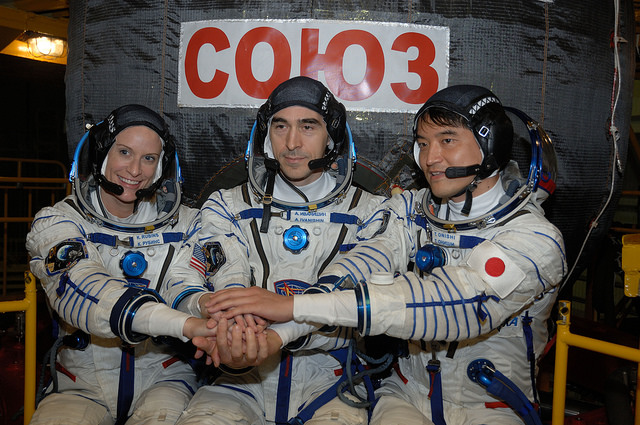
A retired Russian Air Force fighter pilot, a former Boeing 767 copilot, and a civilian microbiologist who describes herself as a “former virus hunter” will launch from the Baikonur Cosmodrome in Kazakhstan at 7:36 a.m. local time on Thursday, 7 July (9:36 p.m. EDT on Wednesday, 6 July), bound for almost four months aboard the International Space Station (ISS). Russia’s Anatoli Ivanishin, Japan’s Takuya Onishi, and NASA astronaut Kate Rubins will fly the maiden voyage of the new “Soyuz-MS” spacecraft and, as such, will embark on a standard two-day rendezvous profile, arriving at the orbital outpost late Thursday. The trio will form the second half of Expedition 48, under the command of Jeff Williams, then rotate into the “core” of Expedition 49, through their return to Earth in late October.
Forty-seven-year-old Anatoli Ivanishin wrapped up two decades of service in the Russian Air Force when he retired from active military duty in 2012, shortly after his first space mission. Born in Irkutsk on the banks of the Angara River and one of Siberia’s largest cities, he dreamed of aviation from childhood and made his first parachute jump at the age of 14. His first attempt in 1986 to enter the Chernigov Higher Military Aviation School for Pilots was unsuccessful—by his own admission he was “not a good student”—and Ivanishin completed a year at Irkutsk Polytechnic Institute before a second attempt in 1987. This time, he succeeded and graduated from Chernigov with a coveted gold medal in 1991.
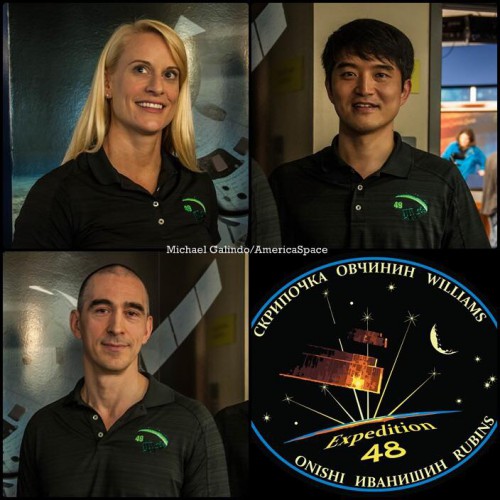
Within the Russian Air Force, Ivanishin flew the Mikoyan MiG-29 and its larger cousin, the Sukhoi Su-27, as a fighter pilot in the Voronezh and Karelia regions, as well as cementing his parachuting credentials. In 2003, he graduated in economics, statistics, and information theory from Moscow State University and in May of that same year was selected as a cosmonaut candidate. After two years of training and evaluation, Ivanishin became a test-cosmonaut and initially served in 2010-2011 on the Soyuz TMA-20M and Soyuz TMA-21M backup crews, before rotating into the prime crew for Soyuz TMA-22M. He launched on his first space mission on 14 November 2011, alongside Russian cosmonaut Anton Shkaplerov and NASA’s Dan Burbank. The three men spent 5.5 months aboard the ISS, initially as the second half of Expedition 29 and later as the core of Expedition 30. Upon his return to Earth on 27 April 2012, Ivanishin had accrued more than 165 days in space and 2,580 orbits of the Home Planet.
Commanding the Soyuz-MS tomorrow, Ivanishin will occupy the center seat aboard the first flight of the fourth generation of this historic spacecraft, whose heritage dates back to the mid-1960s. Seated to his left side will be 41-year-old Takuya Onishi, Japan’s 11th astronaut, who will be embarking on the first spaceflight of his career. Born in the Nerima ward of Tokyo, he studied aeronautical and space engineering at the capital’s university, graduating in 1998. Onishi joined All Nippon Airways, Ltd. (ANA) that same year, initially working within the passenger service department at Tokyo’s Haneda Airport as a check-in agent, before beginning dedicated flight training. Two years were spent on basic instruction in Bakersfield, Calif., followed by a year of advanced training in Tokyo. In October 2003, Onishi became a copilot for ANA’s Boeing 767 fleet and flew both domestic and international routes over the next six years.
He was selected by the Japan Aerospace Exploration Agency (JAXA) as part of a group of new astronauts—alongside Kimiya Yui and Norishige Kanai—in February 2009. He retired from ANA and underwent early training at the Tsukuba Space Center in Japan. Onishi subsequently moved to the Johnson Space Center (JSC) in Houston, Texas, to begin training alongside NASA’s 20th group of astronaut candidates, who were selected in June 2009. One of his fellow “Ascans” was Kate Rubins. Born in Farmington, Conn., Rubins grew up wanting to be “in order, an astronaut, a geologist and a biologist.” Her initial aspiration in achieving the primary goal was to become a fighter pilot, but she was introduced to public health prevention of HIV in high school and attending a DNA conference carried her career in a somewhat different direction.
“I became fascinated with molecular biology and viruses,” recalled the now 37-year-old Rubins, “and have been going along that path for the last 15 years.” She received her degree in molecular biology from the University of California at San Diego and entered the Infectious Diseases Laboratory at La Jolla’s Salk Institute for Biological Studies to analyze HIV integration mechanisms. During this period, Rubins earned her PhD in cancer biology from Stanford University and worked with the U.S. Army and the Centers for Disease Control and Prevention to develop the first model of smallpox infection. She later served as a principal investigator at the Whitehead Institute for Biomedical Research at MIT in Cambridge, Mass., leading a team to focus on viral diseases in Central and West Africa. Her work included the genome sequencing of the Ebola and Marburg filoviruses and Lassa Fever, as well as joint work to develop possible therapies. A scuba diver and triathlon competitor, Rubins is also a keen aviator and parachutist.
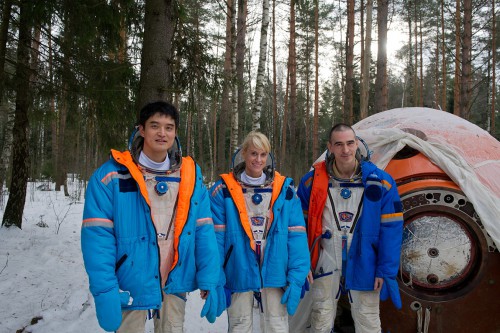
Ivanishin, Onishi, and Rubins came together as a crew in the late spring of 2014, although JAXA had announced the selection of its astronaut the previous November. Ivanishin’s name was attached to the mission in early 2014 and Rubins began her formal training at the Gagarin Cosmonauts Training Center (GCTC) at Star City, on the forested outskirts of Moscow, in June. The trio was announced by NASA in February 2015 and initially served as backups to Yuri Malenchenko, Tim Kopra, and Tim Peake for Soyuz TMA-19M, before rotating into the prime crew assignment for Soyuz MS-01.
As outlined previously by AmericaSpace, the fourth-generation Soyuz-MS is equipped with higher-efficiency solar arrays, better propulsion system redundancy, the new “Kurs-NA” (“Course”) rendezvous hardware, a lighter flight computer, and improved telemetry, control, and autonomous navigation capabilities. It was originally planned to make its debut in March 2016, ferrying Jeff Williams and his Russian crewmates Alexei Ovchinin and Oleg Skripochka into orbit, but could not be readied in time. As a result, Williams’ crew was switched onto Soyuz TMA-20M—the final outing of the older-specification variant of the spacecraft—and Ivanishin’s crew was moved onto Soyuz MS-01. Many of the systems for the new Soyuz have been extensively tested aboard the new Progress-MS cargo ship, whose maiden voyage launched in December 2015 and was completed last weekend.
Since this is the maiden voyage of Soyuz-MS, Ivanishin, Onishi, and Rubins will adopt a “standard” two-day rendezvous profile to reach the ISS, in contrast to the six-hour and four-orbit “fast rendezvous” typically followed by incoming crews since March 2013. “The Russian flight control team will test upgraded command and telemetry system, upgraded approach and attitude-control thrusters, omni-directional antennas, a single Kurs automated rendezvous antenna, additional redundant electrical motors for the docking assembly and the efficiency of the solar arrays” during the extended approach regime, according to NASA’s Rob Navias. The new command and telemetry system, in particular, will enable radio communications coverage for up to 70 percent of each orbit, via Russia’s Luch-5 relay satellite system.
As it presently stands, their mission may turn out to be the shortest ISS increment in almost seven years. Originally scheduled to run from May through late October, the previous increment of Expedition 47 was extended by a month until early June and subsequently by two additional weeks, finally returning to Earth on 18 June. This led to a corresponding move of the Soyuz MS-01 launch to 24 June. In the meantime, the spacecraft was put through leak checks in the vacuum chamber at Baikonur in the second half of May, before being transferred to Site 254 for further inspections. However, the requirement to perform additional software tests prompted an additional delay of two weeks to the night of 6/7 July, but the targeted landing date of 30 October remained unchanged.
This will produce a total mission duration of 116 days for Ivanishin, Onishi, and Rubins, marking the shortest increment to the ISS since NASA astronaut Nicole Stott’s 90-day stay during Expedition 20/21 in the fall of 2009. That said, last year’s Soyuz TMA-17M mission—whose own launch had met with extensive delay—was extended by several weeks beyond its original landing date. It remains to be seen if the Soyuz MS-01 flight will be similarly extended whilst in orbit.
Ivanishin, Onishi, and Rubins and their backup crew of Russian cosmonaut Oleg Novitsky, France’s Thomas Pesquet and former NASA Chief Astronaut Peggy Whitson flew from Star City to Baikonur on 24 June to enter their final days of pre-flight preparations. In parallel, Soyuz MS-01 was loaded with propellants and compressed gases and was encapsulated within its payload fairing, ahead of integration atop the Soyuz-FG launch vehicle on Sunday, 3 July. A direct descendent of the R-7 Intercontinental Ballistic Missile (ICBM), the Soyuz-FG comprises a central “core” and four tapering, strap-on boosters, fueled by liquid oxygen and a highly refined form of rocket-grade kerosene, known as “RP-1.”
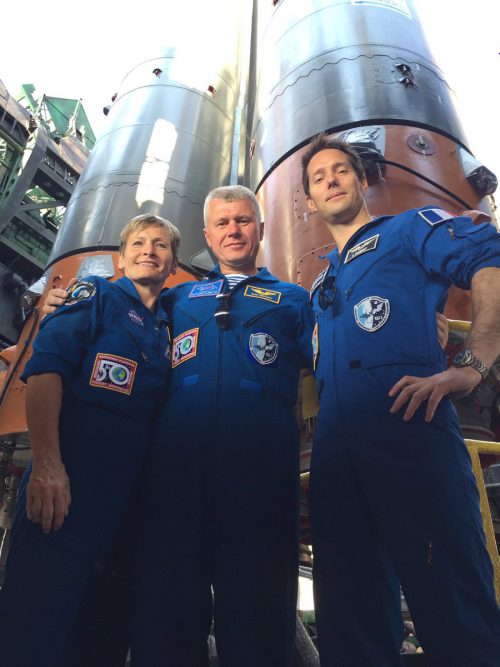
“Standing under a 300-ton rocket,” tweeted Pesquet on Sunday, sharing an image of himself, Novitsky and Whitson. “What could possibly go wrong?” Early on Monday morning, the booster was rolled horizontally from the assembly building to Site 1/5—the famed “Gagarin’s Start”—where it was raised to a vertical height of 162.4 feet (49.5 meters). Emblazoned on the side of the booster was the number “70,” representing this year’s 70th anniversary of the foundation of RSC Energia, Russia’s principal developer of human spaceflight systems.
The prime and backup crews will be awakened tomorrow about 8.5 hours before T-0. They will shower and be disinfected, after which microbial samples will be taken in support of scientific and biomedical experiments. A traditional blessing by a Russian Orthodox priest will be followed by the signing of their Cosmonaut Hotel bedroom doors and departure for Baikonur’s Site 254, where they will don their Sokol (“Falcon”) launch and entry suits. This will also give them the opportunity—from behind glass screens—to bid farewell to their friends and families. At Site 1/5, the crew will be inserted into Soyuz MS-01, with Ivanishin assuming the center seat, flanked by Onishi to his left and Rubins to his right.
Aboard the spacecraft, it has become traditional for crews to carry a “gravity indicator” to notify them of the onset of weightlessness. Typically, this is provided by one of the crew members’ children and for tomorrow’s mission it will be a soft toy bear named “Rilakkuma.” It has been provided by Onishi’s daughter. According to his manufacturer, the Japanese stationery company San-X, Rilakkuma mysteriously appeared in the apartment of a secretary named Kaoru and decided to take up residence there. On 6/7 July 2016, Rilakkuma will instead take up residence in the decidedly more cramped “apartment” of Soyuz MS-01, where he will take up residence for the next several months.
Launch is targeted for 7:36 a.m. local time on Thursday, 7 July (9:36 p.m. EDT on Wednesday, 6 July), after which the Soyuz-FG will rise into the night sky under the combined impulse of the RD-108 core engine and the four RD-107 engines of its strap-on boosters. The four boosters will be jettisoned after two minutes, with the RD-108 continuing the push upwards for the remainder of first-stage flight. The final stage of the Soyuz-FG will then boost Ivanishin, Onishi, and Rubins to 13,420 mph (21,600 km/h) and by the time it separates from the stack at nine minutes after launch the crew will have attained a preliminary orbit of 125 x 160 miles (200 x 260 km), inclined 51.6 degrees to the equator. At this time, Onishi and Rubins will become the 545th and 546th humans to enter space.
Their two-day flight profile will draw them inexorably closer to the ISS and they are targeted to dock at the Earth-facing (or “nadir”) port of the Rassvet module. This is the same port recently vacated by Malenchenko, Kopra, and Peake aboard Soyuz TMA-19M. Ivanishin, Onishi, and Rubins will have little time to become acclimated to their new environs, for a busy period of space station operations lies ahead. Current plans call for SpaceX’s CRS-9 Dragon—conducted under the language of the Commercial Resupply Services contract with NASA—and Russia’s Progress MS-03 to launch in the mid-July timeframe, followed by Orbital ATK’s OA-5 Cygnus in mid-August. The arrival of the SpaceX Dragon will also bring the first Boeing-built International Docking Adapter (IDA), which is due to be installed onto the forward end of the Harmony node during an EVA by Williams and Rubins “around the third week of August.” In comments provided to AmericaSpace, Rob Navias noted that specific details for the EVA, including “get-ahead” tasks, are currently being refined.
Williams, Ovchinin, and Skripochka are currently scheduled to return to Earth on 7 September, wrapping up almost six months in orbit, after which Ivanishin will assume command and lead the new Expedition 49 until the end of his own mission. Later in September, the station will welcome NASA astronaut Shane Kimbrough and his Russian crewmates Sergei Ryzhikov and Andrei Borisenko, thereby bringing Expedition 49 up to its full, six-person strength. Flying aboard Soyuz MS-02, Kimbrough, Ryzhikov, and Borisenko will also follow a two-day rendezvous, although it remains undecided if subsequent crews will do the same or revert to the shorter approach profile.
Want to keep up-to-date with all things space? Be sure to “Like” AmericaSpace on Facebook and follow us on Twitter: @AmericaSpace
Missions » ISS » Soyuz TMA-M » Missions » ISS » Soyuz TMA-M » Soyuz-MS-01 »



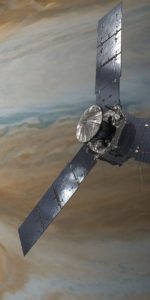
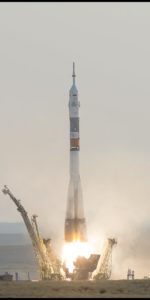
One Comment
One Ping
Pingback:Expedition 48 Spacewalkers Restore Space Station Power Channel to Pre-2012 Configuration « AmericaSpace